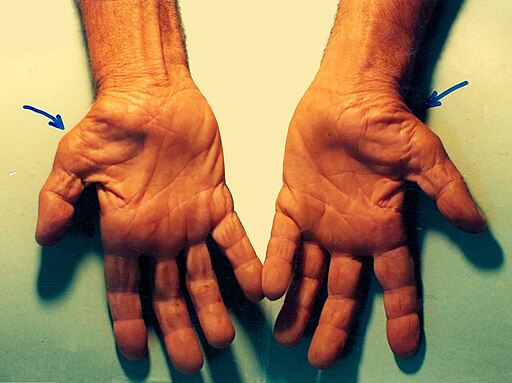🔌 Entrapment Neuropathies
🔑 Key Learning
-
Carpal tunnel syndrome = compression of the median nerve at the wrist → paraesthesia in lateral 3.5 fingers.
-
Cubital tunnel syndrome = compression of the ulnar nerve at the elbow → medial hand paraesthesia, claw hand.
-
Radial tunnel syndrome = compression of the posterior interosseous nerve → dorsal forearm pain, worse with resisted extension.
✋ Carpal Tunnel Syndrome
🧬 Pathophysiology
-
Compression of the median nerve within the carpal tunnel at the wrist.
-
The carpal tunnel contains:
-
9 flexor tendons
-
Median nerve
-
RFs: Repetitive activities (e.g. typing, painting, gardening), pregnancy, diabetes, RA, hypothyroidism, obesity
 Figure 229: The Carpal Tunnel. OpenStax College, CC BY 3.0.
Figure 229: The Carpal Tunnel. OpenStax College, CC BY 3.0.
👀 Clinical Features
-
Sensory:
-
Paraesthesia/pain in the lateral 3.5 fingers and lateral palm (excluding the thenar eminence due to palmar cutaneous branch)
-
Worse at night, often wakes patients from sleep
-
Patients may shake hands for relief
-
Motor:
-
Weak grip
-
Difficulty with fine motor tasks
-
Thenar wasting in advanced disease
🧪 Examination
-
Phalen’s test: wrist flexion for 60 seconds reproduces symptoms
-
Tinel’s test: tapping over the median nerve reproduces tingling
-
Thenar wasting, reduced sensation, weak thumb abduction
 Figure 230: Thenar wasting in a patient with untreated carpal tunnel syndrome.
Figure 230: Thenar wasting in a patient with untreated carpal tunnel syndrome.
🔍 Investigations
-
Clinical diagnosis
-
Nerve conduction studies: used to confirm and assess severity
💊 Management
-
Mild-moderate:
-
Nocturnal wrist splinting
-
Corticosteroid injection
-
Severe/persistent:
-
Nerve conduction studies
-
Surgical decompression (carpal tunnel release)
🦵 Cubital Tunnel Syndrome
🧬 Pathophysiology
-
Compression of the ulnar nerve in the cubital tunnel (between the medial epicondyle and olecranon)
 Figure 231: The ulnar tunnel - a site of entrapment ulnar neuropathy. InjuryMap, CC BY-SA 4.0.
Figure 231: The ulnar tunnel - a site of entrapment ulnar neuropathy. InjuryMap, CC BY-SA 4.0.
👀 Clinical Features
-
Sensory:
-
Paraesthesia in medial 1.5 fingers and hypothenar eminence
-
Motor:
-
Weak grip
-
Clawing of 4th/5th digits
-
Wasting of interosseous muscles
🧪 Examination
-
Tinel’s at the elbow
-
Elbow flexion test: symptoms reproduced with prolonged flexion
-
Froment’s sign (paper grip test): tests adductor pollicis weakness
💊 Management
-
Avoid prolonged elbow flexion
-
Elbow pad/night splint
-
Nerve conduction studies if persistent
-
Surgical decompression if progressive symptoms
💥 Radial Tunnel Syndrome
🧬 Pathophysiology
-
Compression of the posterior interosseous nerve (a branch of the radial nerve) in the radial tunnel (just distal to lateral epicondyle)
👀 Clinical Features
-
Vague dull ache or burning pain over dorsolateral forearm
-
Pain worse with resisted supination/pronation
-
No sensory changes (PIN is motor only)
-
Worse at night, may mimic lateral epicondylitis
🧪 Examination
-
Pain with resisted middle finger extension or thumb extension
-
Tenderness 3–5 cm distal to lateral epicondyle
-
Rule out tennis elbow (more focal, tender directly over epicondyle)
💊 Management
-
Activity modification, NSAIDs
-
Splinting
-
Physiotherapy
-
Surgical decompression if refractory
📝 Exam Clues & Clinchers
-
Median nerve = carpal tunnel, nocturnal symptoms, thenar wasting
-
Ulnar nerve = medial 1.5 fingers, claw hand, Froment’s sign
-
Posterior interosseous nerve = dorsal forearm pain, no sensory deficit



